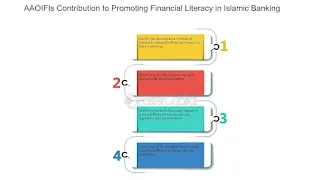The topic "The Influence of Financial Literacy Level on the Use of Islamic Financial Products" explores how individuals' understanding of financial concepts impacts their decisions to engage with Islamic banking and financial services. Here's a structured overview to help you develop this topic into a report, paper, or presentation:
1. Introduction
- Background: Growth of Islamic finance globally and its role in financial inclusion.
- Problem Statement: Despite the availability of Islamic financial products, their adoption remains relatively low in some regions. One possible reason is the lack of financial literacy.
- Purpose: To investigate whether financial literacy levels influence the use of Islamic financial products.
2. Literature Review
- Financial Literacy: Definition, components (budgeting, saving, investing, debt management), and its measurement.
- Islamic Financial Products: Basic types (Murabaha, Ijarah, Mudarabah, Sukuk, Takaful) and their unique principles (Shariah compliance, risk-sharing).
- Previous Studies: Summary of empirical findings linking financial literacy with financial behavior, especially in Islamic finance contexts.
3. Conceptual Framework
- Independent Variable: Financial literacy level (could include basic financial knowledge, Islamic finance knowledge, numeracy skills).
- Dependent Variable: Usage of Islamic financial products (measured by product adoption, frequency of use, product diversity).
- Control Variables: Age, income, education, religiosity, availability of Islamic financial services.
4. Methodology
- Approach: Quantitative survey or mixed-method.
- Population/Sample: Individuals in Muslim-majority countries or regions with access to Islamic finance.
- Instruments: Standardized financial literacy assessment tools, questionnaires on product usage.
5. Expected Findings
- Higher financial literacy may positively correlate with increased use of Islamic financial products.
- Awareness of Shariah principles and product structures could boost consumer trust and adoption.
6. Implications
- For Policymakers: Need to integrate Islamic finance in national financial literacy strategies.
- For Financial Institutions: Design targeted educational campaigns to improve customer understanding.
- For Researchers: Open avenues for deeper study into behavioral aspects and regional variations.
7. Conclusion
- Recap the importance of financial literacy in promoting the effective use of Islamic financial services and enhancing financial inclusion.
Here is a literature review section on the topic "The Influence of Financial Literacy Level on the Use of Islamic Financial Products":
Literature Review
1. Financial Literacy: Definitions and Dimensions
Financial literacy is commonly defined as the ability to understand and effectively use various financial skills, including personal financial management, budgeting, and investing (Lusardi & Mitchell, 2014). It encompasses knowledge of financial concepts, numeracy skills, and the ability to make informed financial decisions. The Organisation for Economic Co-operation and Development (OECD, 2013) describes financial literacy as a combination of awareness, knowledge, skill, attitude, and behavior necessary to make sound financial decisions and achieve individual financial well-being.
Several dimensions of financial literacy have been identified in the literature: (i) basic financial knowledge (e.g., interest rates, inflation, risk diversification), (ii) advanced financial knowledge (e.g., investment strategies, financial instruments), and (iii) behavioral aspects such as saving habits and financial planning (Huston, 2010). In recent years, Islamic financial literacy—knowledge of Shariah-compliant financial principles and products—has emerged as a critical sub-dimension in Muslim-majority contexts.
2. Islamic Financial Products: Principles and Adoption
Islamic financial products are structured in accordance with Islamic law (Shariah), which prohibits interest (riba), uncertainty (gharar), and speculative behavior (maysir). Products such as Murabaha (cost-plus financing), Mudarabah (profit-sharing), Ijarah (leasing), and Takaful (Islamic insurance) offer alternatives to conventional financial instruments while aligning with Islamic ethical standards (Obaidullah & Khan, 2008).
Despite the growing availability of Islamic financial services globally, their adoption remains uneven. Factors influencing usage include religiosity, perceived trust and transparency, service quality, and awareness of product offerings (Abduh & Omar, 2012). Many consumers express interest in Islamic finance due to its religious compliance, but often lack the knowledge needed to fully understand the product mechanisms (Lajuni et al., 2018).
3. Link Between Financial Literacy and Use of Islamic Financial Products
Empirical studies indicate a positive relationship between financial literacy and financial product usage. For instance, Lusardi and Tufano (2015) found that individuals with higher financial literacy were more likely to plan for retirement and use diversified financial products. In the context of Islamic finance, several studies support the hypothesis that greater Islamic financial literacy leads to increased adoption of Islamic financial products.
Rahim et al. (2016) found that Islamic financial literacy significantly influenced the intention to use Islamic banking services among Malaysian university students. Similarly, Abdullah and Anderson (2015) noted that awareness and understanding of Islamic financial instruments were significant predictors of their usage. This implies that enhancing individuals' knowledge of Islamic finance could play a critical role in expanding the Islamic finance market.
However, the relationship is not purely linear. Factors such as access to Islamic financial institutions, socio-economic status, and trust in the Islamic banking system also mediate the influence of financial literacy on usage (Kassim & Abd Majid, 2010). Some studies also highlight the role of religious commitment, suggesting that in highly religious populations, even low levels of financial literacy may not deter Islamic product adoption if religious motivation is strong (Mahdzan & Tabiani, 2013).
4. Research Gaps
While there is growing literature on financial literacy and Islamic finance individually, limited research explores the direct causal links between financial literacy levels and the usage of Islamic financial products across diverse populations. Most studies focus on specific groups (e.g., students or urban populations), leaving rural or lower-income segments underrepresented. Moreover, there is a need for standardized tools to measure Islamic financial literacy in order to enable consistent cross-regional comparisons.







